
by Sarah Derouin Monday, December 11, 2017
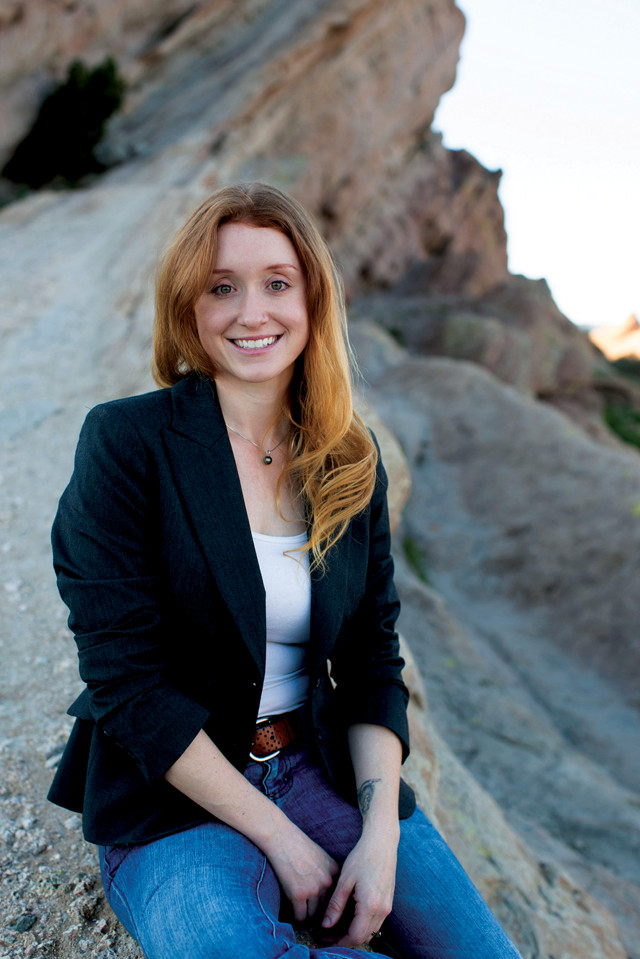
Jess Phoenix, a volcanologist and co-founder of Blueprint Earth — a nonprofit organization that brings scientists together with students to inventory ecosystems — is running for Congress in California's 25th District. Credit: Belle & Epic Photography.
Field geologists usually love camping, hiking and all things outdoors. Today, Jess Phoenix is no different, but she wasn’t always that way. As a child growing up in Colorado, she bucked traditional backpack-wearing pursuits. “I would take the horses on trail rides and that was probably the most outdoorsy thing that I did,” Phoenix says. Instead, she took after the athletic interests of her parents, both FBI agents, playing “every sport under the sun.”
Also an avid reader, Phoenix originally wanted to be an English professor. “I’ve always been very curious — if you give me a book, I’ll read it. It doesn’t matter what it’s about,” she says. Phoenix attended Smith College in Northampton, Mass., where she majored in history and was a member of the equestrian team. After graduation, she worked for a few years doing historical archival work for the state of Arizona, before going back to school to get a master’s degree in volcanology at California State University, Los Angeles, studying Loihi, an undersea volcano off the coast of Hawaii.
She also researched volcanism and lava flows in the Sierra Madre Occidental Range of Mexico while at Queensland University of Technology in Australia and National Autonomous University of Mexico. Phoenix then worked as a geologist doing natural resources work and minesite geology.
Five years ago, Phoenix and her husband Carlos (both of whom changed their last names to Phoenix from Peláez, which they kept as a middle name, because they wanted something easier to pronounce) leveraged their passion for education and science to found Blueprint Earth, a nonprofit organization that brings scientists together with students to collaboratively inventory the biological and physical traits of selected areas, and to document the connections between the geosphere, biosphere, hydrosphere and atmosphere to create a “blueprint” of that ecosystem.
Last year, Phoenix was featured in the six-part Discovery Channel series “Trailblazers,” including an episode in which she led a trip to El Reventador Volcano in Ecuador. This year, she appeared in “Devil Sharks” during the Discovery Channel’s Shark Week, and completed scientific commentary for another show in August. She still does volcano research for the Discovery Channel, Science Channel and other groups and will consult on natural hazards issues for governments and private companies.
She recently decided to put her scientific knowledge, adventurous nature and communication skills to work in a new arena and has thrown her hiking boots into the ring as a candidate to represent California’s 25th Congressional District. The election is in November 2018.
Phoenix recently spoke with EARTH’s Sarah Derouin about why volcanoes are awesome, her work communicating science and the need for more scientists in politics.
SD: How did you become a geologist?
JP: I didn’t realize that geology was anything you could really study or make a career of until I was in college. I took a visiting semester at the University of Massachusetts at Amherst and, just for fun, I took a bunch of classes that sounded interesting, one of which was introductory geology. The class was extremely dry — we didn’t go outside or anything — but I loved it. I was a history major, and geology is the history of Earth; you can’t get any older than that. It answered questions for me that I had had my whole life.
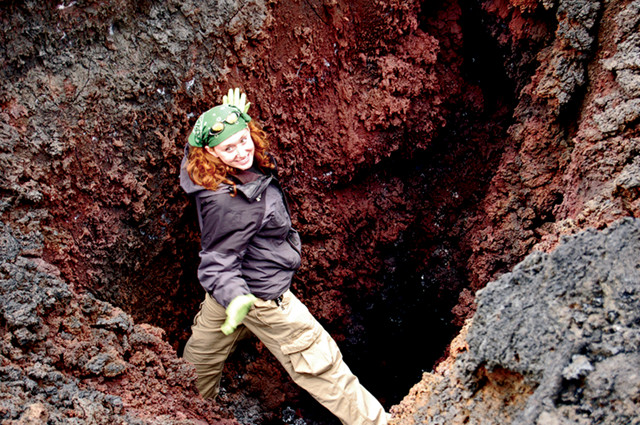
Phoenix explores a volcanic vent on the summit of Mauna Loa in Hawaii. Credit: Steve Schilling.
SD: What is so special about volcanoes?
JP: They are the most obvious proof that Earth is still alive, that it’s still evolving and changing. We can see new Earth being formed — you can sample it when it’s still cooling. That’s powerful because you are witnessing the creation of something, true creation. That’s amazing to me because it’s not mystical. It’s not something far away that’s inaccessible. If you can afford to go to a place with an erupting volcano, you can see Earth renewing itself, and to me, that’s just spectacular.
SD: Why is Blueprint Earth needed?
JP: Science is becoming extremely specialized — you focus so much that sometimes you miss the forest for the trees. With Blueprint Earth, the concept is that science informs everything we do in our lives. It’s so integral, and we have to make people understand that things are connected. We can create blueprints of Earth’s environments in an interdisciplinary way. As a geologist, I’ll know about the rocks and the processes that shape the landscape; my biologist friends will know what different species are there and what their relationships are to each other; the atmospheric scientists will understand why the weather systems form and the patterns and why things are changing; and the hydrologists will understand where the water comes from, why it’s present. This is great, but we need to combine them. There are some groups that do similar things, like the Critical Zone Observatories — they’ve been great and worked with us, particularly when we were getting started.
SD: How do you involve students in the work?
JP: We use student researchers to collect the large amounts of data we need to catalog everything in an environment. We take teams of students, both graduate and undergraduate, and we match them up with scientists who lead the different teams. We go out to the Mojave Desert — the first environment we went to needed to be accessible to students. I didn’t want it to be something that was reserved for students who could afford to do a long field project. We basically do it at no cost to the student. If they can get to L.A. or Las Vegas and get the time off work — because most of our students work — we fit it in during school breaks.
SD: Once the group is assembled, what happens?
JP: We set up camp and hike out into the Mojave for the day. We go out and do our work during the day, we come back and have a campfire at night — it’s a lot of fun. They get a chance to use techniques, sort of a blend of academia and industry, because I have a background in both. We’re using accepted methodologies to collect data about what is in the environment — everything from microbes to clouds. The students and scientists talk with each other across disciplines to figure out connections, saying, “Hey, you know what? We’re seeing these toads, but only where we have this plant and it seems to grow in sandy and gravelly substrates, but only if the gravel is smaller than a certain size.”
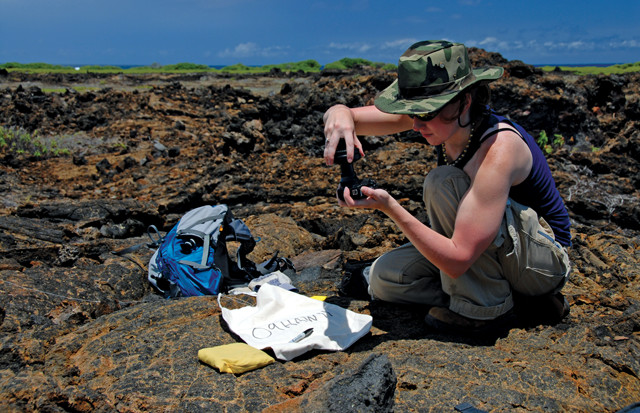
Phoenix prepares to photograph a site in Hawaii being sampled for cosmogenic nuclide analysis. Credit: Joe Licciardi.
SD: What kind of effect does a field program like Blueprint Earth have on students?
JP: When they start, a lot of these students say, “I’m taking biology but the only career option I know about is nursing,” and I’m like, “Oh, well, let me tell you!” [laughs] It’s basically introducing students from all sorts of different backgrounds to the joy and love of fieldwork and doing some great science along the way.
To date, 76 percent of our students have been female, 54 percent have been people of color, 60 percent have come from low-income backgrounds. Ultimately, the students are getting great hands-on research experience. We’ve already had students go on to do doctoral work and get jobs as lab techs and wildlife biologists. For example, one of them is working in the Grand Canyon doing wildlife biology.
We’re just now getting some data ready for our first peer-reviewed publication. We’ve done a lot of posters and presentations at conferences, but now we have enough to publish, so that will be fantastic.
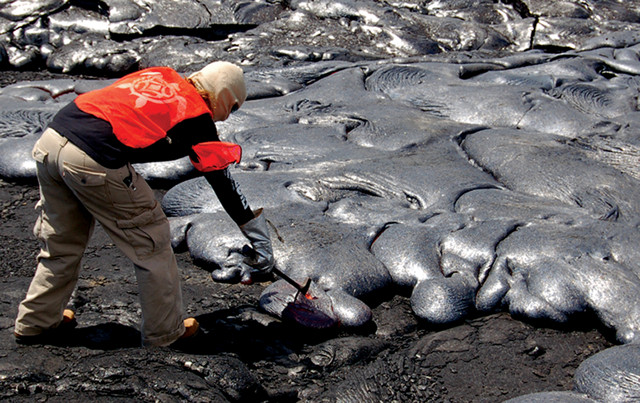
Phoenix samples a young pahoehoe lava flow on the Waikupanaha lava field in Hawaii. Credit: Matt Patrick.
SD: What approaches work for getting underrepresented students interested in the geosciences?
JP: I think what really works is going to schools, telling students what we offer, finding professors who say, “I have some students who’d be great for this,” and getting the word out. It’s all about communication — telling them “Yes, you can” — and showing them scientists who look like them.
To that end, we don’t just reach out to college and university students; we have an elementary school program where we bring scientists into the classrooms of second through fifth graders. The school is a STEAM Academy in the L.A. public schools. It serves a typically under-resourced community, in which 99 percent of the children are Latino. The scientists show pictures and tell stories about their work. Then we have a hands-on component where the scientists show some of the tools and the students get to touch the rock hammer and hand lens, and see the hydrochloric acid reacting on carbonate. I go wearing my field boots and backpack.
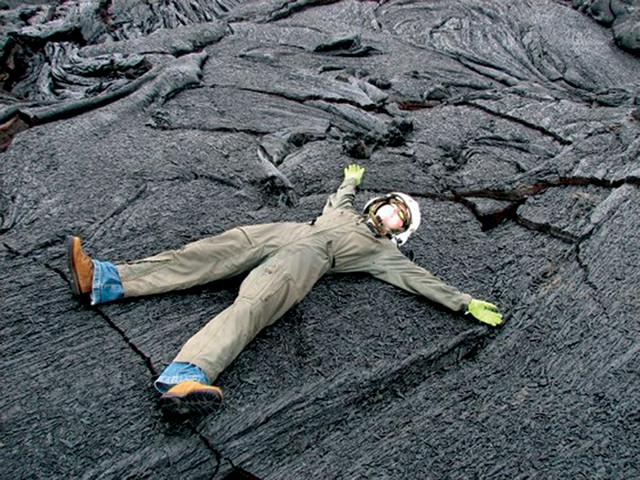
Waiting for a helicopter pickup on the side of Kilauea Volcano allowed Phoenix to work on her best "lava angel" in Hawaii. Credit: Matt Patrick.
SD: It sounds like you are busy with science education and communication. When did you decide to also run for Congress?
JP: Well, the last election hit me pretty hard because, immediately, what came to mind were threats to the planet, threats to people I care about.
I realized the implications for the Environmental Protection Agency, for the U.S. Geological Survey, for NOAA, for NASA — and for my family: My husband is Latino and his mother was undocumented when he was a kid. She received amnesty under President Reagan, but as a child he had to live in fear that his mother could be taken away. No kid should have to live like that.
I didn’t want to go into politics — talk about a reluctant politician. I’d much rather just stick to doing research and working on science. But if we have no funding, if I can’t compete for grants because there are no funding dollars — these are things we just can’t ignore. We need clean air and clean water. The EPA is vital. And the fact that some politicians want to cut the earthquake early warning system and the tsunami warning system and the hurricane warning system … I mean, it was kind of an overwhelming cascade of things, and I went “Ok, fine. I’ll give it a shot.” And if people like the idea of evidence-based policymaking, then I’ll do great.
I think scientists would be fantastic in Congress because we bring that scientific training and understanding of how to research and analyze all available data and use that to inform our analysis. I think that’s what is needed in politics.
Congress was supposed to be representative of society; it was supposed to be people from different walks of life, backgrounds, skillsets, and that’s not what we have. We have nowhere near parity with gender representation, and we don’t [have parity] for professions either.
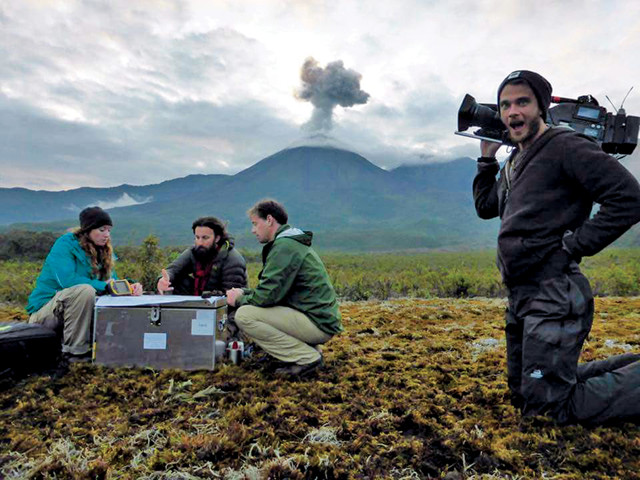
Phoenix has been featured on several Discovery Channel shows, including "Trailblazers," an episode of which was filmed on El Reventador Volcano in Ecuador. Credit: Danny Etheridge.
SD: Are there similarities between running for Congress and getting people interested in science?
JP: There really are. To me, it’s all about educating people — that’s fundamentally what it comes down to. Everything we deal with and all the divides that we see tend to come from a lack of education and understanding. It all flows through communication. So if we can better educate people by communicating opportunities available to them, and resources that are available to them, we’re going to be doing a lot better as a society. I think that’s how we start to heal a lot of the divides that we see at the moment: through talking, and sharing knowledge and information.
© 2008-2021. All rights reserved. Any copying, redistribution or retransmission of any of the contents of this service without the expressed written permission of the American Geosciences Institute is expressly prohibited. Click here for all copyright requests.